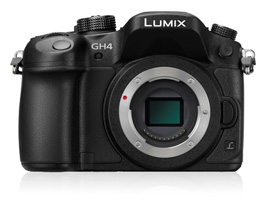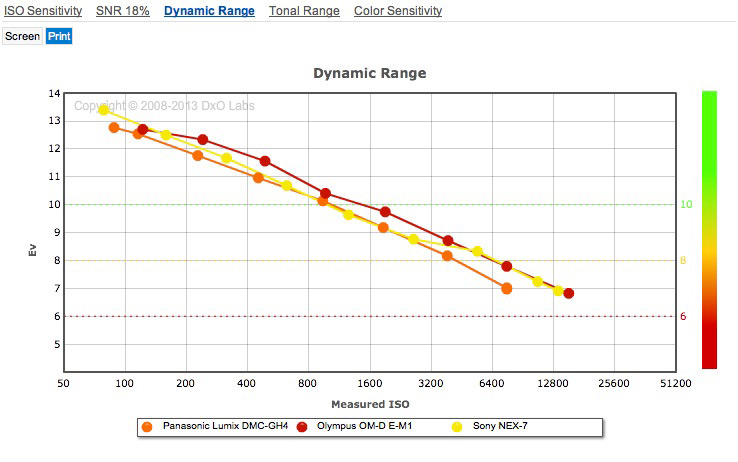Introduction
As the successor to the popular and capable video-oriented Lumix DMC GH3 the new revamped model the GH4 adopts a similar 16-Mpix Live MOS sensor and familiar outer water-and-dust resistant magnesium alloy shell but it has several significant enhancements.
Both the EVF and rear swivel touchscreen LCD have been upgraded in resolution – the viewfinder, for example, up 614K dots from 1.7M to 2.36M, while a new more powerful quad-core Venus image processor has been employed to facilitate a new maximum 25,600 ISO setting and continuous shooting in Raw mode up to 12 fps (AF-S), 7 fps (AF-C), or up to 40 fps (without AF).
Like its predecessors, the GH4 also has expanded video-capture capabilities over other models in the range. The most significant and tempting features being in-camera 4K and Full HD capture with a range of resolutions, frame rates and high bit-rates. The 200 Mbps (All-I) high-bit rates refer to Full HD however, with 100 Mbps (IPB) being limited to 4K capture in a ‘cinematic’ 24p option at 4096 x 2160 or 3840 x 2160 at 30/24p. Curiously, both 4K modes have an option to record an 8.8-Mpix still during capture.
The GH4 can also be paired with an optional interface unit – a large battery grip like accessory that adds a raft of industry-standard ports that are simply too large to build into the relatively compact body of the camera. The Panasonic Lumix DMC-GH4 measures 5.2 x 3.7 x 3.3″ / 132.9 x 93.4 x 83.9 mm and weighs 19.75 oz / 560 g. It is available for pre-order at $1,699 body only.
Key specifications
- 16-Mpix Live-MOS sensor
- 12 fps continuous shooting with AF-S (up to 40fps without)
- 49-point Contrast Detect AF
- 0.39-inch 2.36-M dot OLED EVF
- 3.0-inch 1.03-M dot tilt and swivel OLED
- DCI 4K (4096 x 2160) at 24p
- UHD 4K 3840 x 2160 at 30/24p
- Full HD up to 60p
- 4:2:2 8-Bit or 10-Bit via HDMI
- Wi-Fi connectivity with NFC
- Magnesium alloy, weather-sealed body
Panasonic Lumix DMC-GH4: Best performing FT sensor in our database
The new GH4 achieved a DxOMark a score of 74 points somewhat behind the best APS-C size sensors presently available but at the current edge of Four-Thirds devices.
At 23.2 bits, the new Lumix attained an excellent score for color discrimination and it achieved very good score for dynamic-range with a wide 12.Evs. The slight downside, a consequence of the physically smaller sensor is a slightly below par low-light capability though Panasonic has been making some ground in this over earlier models.
Panasonic Lumix DMC-GH4 Versus Olympus OM-D E-M1 Versus Sony NEX-7: Competitive performance
Although the GH4 has commendable video-capabilities it remains Panasonic’s top-of-the-range stills camera and will have to compete with high-end models from rivals.
Against the related sensor in the OM-D E-M1, the GH4 has practically identical performance characteristics; although the E-M1 has DR at higher ISOs while the GH4 has slightly better color discrimination, equivalent to around +1/3 of a stop. Differences begin to appear however, when compared with the physically larger 24-Mpix APS-C sensor in the aging but still hugely capable Sony NEX-7.
The APS-C sensor has the potential to reproduce more nuanced color, equivalent to an increase of around +2/3 stop over the smaller device in the GH4. There’s also +2/3 stop wider dynamic range at base ISO but this advantage quickly diminishes, and only around a +1/3 stop gain in low-light capability over the Panasonic.
Panasonic Lumix DMC-GH4 Versus Panasonic Lumix DMC-GH3 Versus Panasonic Lumix DMC GH2: Slight improvement in IQ over predecessor
At the time of its release Panasonics’ new 16-Mpix chip in the GH3 revealed an increase in performance of around +1-stop over the highly regarded GH2 with its innovative 16-Mpix multi-aspect sensor. However there was a development cycle of some two-years between the GH2 and GH3, and only 17 months between the GH3 and the GH4. As a consequence of that, it seems, the new model shows only around +1/3 stop increase in sensor performance.
It has just under half stop increase in dynamic range and just a marginal improvement of 0.5 bits in color depth on an already excellent score. Although there has been no improvement in the low light score the GH4 and GH3 before it have a slight edge over the older GH2.
Conclusion
With this new high-end video-oriented model Panasonic is widening the appeal of its cameras. Although the high-end video features will tempt new users the GH4 is also a highly specified and capable stills camera.
The sensor performance is on a par with the highly regarded Olympus OM-D E-M1 and is competitive when viewed against rivals using APS-C size sensors. Sony has yet to revise the aging NEX-7 though the new full-frame Sony A7s looks as though the firm is tempted to build more video-centric models. However, for the time being at least the hybrid GH4 looks like a formidable contender for both stills and video users.












DXOMARK encourages its readers to share comments on the articles. To read or post comments, Disqus cookies are required. Change your Cookies Preferences and read more about our Comment Policy.